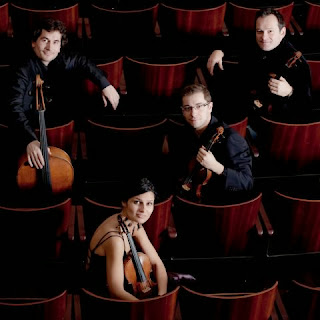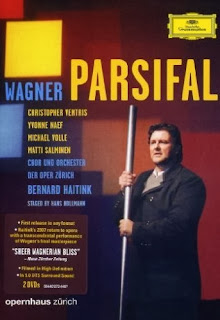'Desert' is probably the wrong word to describe early Minimalism: at the time it must have seemed more like a rainforest after the aridity of Darmstadt's iron rule. So in writing my Arts Desk review of the BBC Singers' and Endymion's reduced-forces version of Steve Reich's 1984 masterpiece The Desert Music, I fumbled for a compromise, 'savannah', in trying to describe the terrain from which it, and earlier (in 1980-1) John Adams's equally individual chorus-and-orchestra spectacular Harmonium, took off. Curiously, and incidentally, that same day I read a passage in Richard Mabey's bewitching Nature Cure where another of my heroes used the term 'savannah' for an image in a different context.
As ever, in trying to sum up what Minimalism was for the students in a 20-minute lecture-room whizz before the Milton Court concert began, and where these two composers departed from its basics, I found my Adams bible, Hallelujah Junction, indispensible. Mighty John is writing about the work in which he first found his voice, Phrygian Gates, having turned 30 by the time Mack McCray gave its premiere in 1977. Forgive me for reproducing such a large chunk of text, but it conveys everything I want to say, and more, from an insider-practitioner's perspective.
I had first heard Terry Riley's epochal In C while still living in Cambridge, probably in 1971. A friend, another composition student, invited me back to his flat with the promise of introducing me to something 'like you've never heard before.' And he was right. What he played for me was the famous Columbia Masterworks LP of the landmark piece that announced a new style in contemporary music. Terry's In C may have been to contemporary American music what Ginsberg's Howl or Kerouac's On the Road were to literature. With its insistent, unyielding high pulse on the high C of a piano and the sunny, upbeat fragments of melodies recirculating over and over in a loose polyphony, In C captured the congenial hippie spirit of the West Coast while at the same time proposing a new, slowly evolving approach to musical form. It was also marvelously provocative, giving an R. Crumb [who? I only know, and love, George*] middle finger to the crabbed, pedantic world of academic modernism.
I later heard more organized, more elegant versions of the Minimalist aesthetic when Steve Reich brought his ensemble to town in 1974. Their performance of Drumming revealed a different but equally novel take on pulsation as the guiding principle of the music - the main event, so to speak - but compared to In C, Reich's materials were more fastidiously organized and the gradual process of melodic, harmonic and timbral evolution more methodical. What also impressed me about Reich's music-making was that it was done at a high level of expertise and preparation. In contrast to the free, anarchic avant-garde happenings I'd been involved with, Reich's music used precision and balanced counterpoint to create a sound world that was carefully organized, musically engaging and sensually appealing.
...What appealed to me about these early works of Minimalism was that they did not deconstruct or obliterate the fundamental elements of musical discourse such as regular pulsation, tonal harmony or motivic repetition. Indeed they did the opposite: they embraced pulsation and repetition with an almost childlike glee. To me, it felt like the pleasure principle had been invited back into the listening experience.
And what of Glass? I have foresworn his company, which means that if I can avoid it I hope never to sit through one of his symphonies or operas again. Adams is brutally frank on the historical limitations.
...But much as they enchanted me, these Minimalist compositions felt like latter-day descendants of Baroque compositions from the 18th century. As musical organisms, the pieces were largely monolithic, their expressive worlds more often than not confined to a single affect. One spoke of trances or hypnotic states. That was both the brilliance of the style's originality and the conundrum of how to make it evolve into a language of greater subtlety...Much of his [Glass's] symphonic music, such as the 1996 'Heroes' Symphony, based on songs by David Bowie and Brian Eno, moves among simple, familiar harmonies in regular symmetrical units of two and four bars, while the orchestration, once established for a movement, remains more or less unchanged.
Those are shortcomings you won't find in The Desert Music or Harmonium. Which is why I'm still startled when someone else labels Reich and Adams (pictured above, much more recently than Reich, by his superb photographer partner Deborah O'Grady) American Minimalists. I've just read an annoying interview in the latest BBC Music Magazine with John Tavener, who says he hates that 'school' on the whole: 'John Adams bores me to tears'. Tavener's longer rituals bore me to tears, as it happens. Adams bores me never, even if I respond to some works more enthusiastically than to others.
The Desert Music certainly isn't for trance states; as Reich says in an interview on the original LP, 'I actually prefer the music to be heard by somebody who's totally wide awake, hearing more than he or she usually does, rather than by someone who's just spaced out and receiving a lot of ephemeral impressions.' As the poetry of William Carlos Williams, a real revelation to me, has it as set in the fourth movement, 'I am wide/awake. The mind/is listening.' The below is a fine performance, even if the choir doesn't 'get' the text in the same way American or British forces seem to.
The opening is anything but Minimalist-diatonic basic: in fact so much of the piece lives in a state of suspension, like Tristan und Isolde, or anxiety (specifically about the nuclear threat) that the hint of an F major resolution, still ambiguous, makes the ending especially luminous.
In that context, I proposed to my great blogging friend Susan Scheid over on Prufrock's Dilemma that we each give a list of 20th century works offering affirmative capability, even if that only comes at the end of the masterpiece in question, one per decade. Here are mine today (they could of course change tomorrow). The Desert Music slotted into the 1980s only by postponing Adams for the 1990s
1900s: Schoenberg's Verklärte Nacht. It was actually composed in 1899, but the Rosé Quartet and two players from the Vienna Philharmonic gave the original sextet premiere in 1902.
1910s: Strauss's Der Rosenkavalier. Especially apt since Salome and Elektra had preceded it.
1920s: tricky - Prokofiev's The Prodigal Son is suitable because of the beautiful homecoming, but Nielsen's Fifth Symphony is the greater work.
1930s Britten's Paul Bunyan. Such optimism, such a libretto (Auden). Having recently been faced with the possibility that several of the 'mature' operas, one especially, might not be as great as I thought they were, I love it the more.
1940s: should really be dividied into war and post-war years, but this is a celebration that manages to be rooted and iconoclastic at the same time: Messiaen's Turangalîla Symphony with its crazy final blaze of a chord out-Scriabining Scriabin.
1950s: Shostakovich's Tenth Symphony. That finale really is raucously celebratory, not hollow, I fancy, with the rampaging of the composer's personal signature. And Stalin really was dead, even if the composer had no great optimism about his successors.
1960s: Poulenc's Gloria. Hits the heights more surely than the earlier Stabat Mater, which I heard on Wednesday and found it eclipsed by Prokofiev's painfully beautiful Seventh Symphony.
1970s: Bernstein's Mass. I see I've gone to the New World for later 20th century optimism from this point on.
1980s: Reich's The Desert Music
1990s: Adams's El Niño. Cheating in quite the opposite way to my choice of Verklärte Nacht: I assume work began at least a couple of years before the Paris premiere in December 2000. Looking forward to hearing it shorn of its Peter Sellars production overload when Jurowski conducts it towards the end of The Rest is Noise festival.
*Howard Lane clarified below: 'R. Crumb is the signature of the cartoonist Robert Crumb of Fritz the Cat, The Fabulous Furry Freak Brothers and Mr Natural fame.'
UPDATE (28/10) Notice board for pre-performance talks I'm involved with this week - four on the trot:
Wednesday 30 October: talking to Michail (father of Vladimir) Jurowski in the Royal Festival Hall about his LPO performance of Schnittke's First Symphony. Sorry to hear that Sasha Ivashkin, who knew Schnittke well, has written and/or put together two marvellous books about him and interprets the great man's cello works as well as anyone, is ill and had to cancel his play-and-talk event: hence this different combination.
Thursday 31 October: Up to Birmingham for a talk before Sinaisky conducting the CBSO in Rachmaninov's The Bells.
Friday 1 November: prefacing the brilliant Belceas' Wigmore performance of quartets by Britten and Shostakovich.
Saturday 2 November: back to the BBC Symphony Orchestra at the Barbican to chat with Tristan Murail and say a bit about Shostakovich's First Piano Concerto and Mahler's First Symphony before Sakari Oramo's first official concert as the BBCSO's chief conductor.




























































